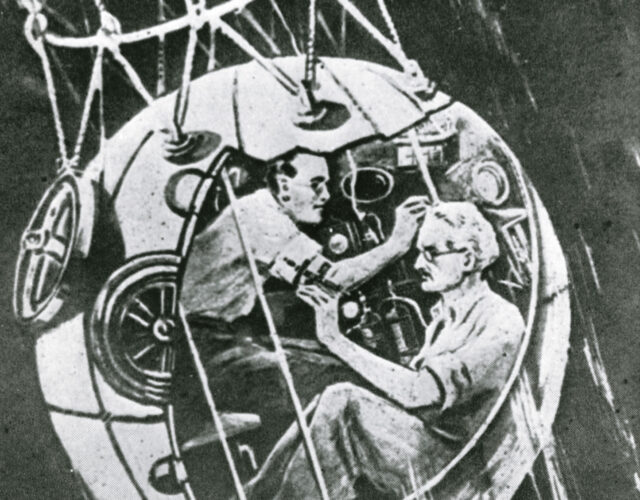Even among scientists, Auguste Piccard was considered an eccentric. But perhaps his most bizarre scientific endeavor was in 1931 when he took a balloon 75,000 feet in the air to prove Einstein’s theory of relativity.
About The Disappearing Spoon
The Science History Institute has teamed up with New York Times best-selling author Sam Kean to bring a second history of science podcast to our listeners. The Disappearing Spoon tells little-known stories from our scientific past—from the shocking way the smallpox vaccine was transported around the world to why we don’t have a birth control pill for men. These topsy-turvy science tales, some of which have never made it into history books, are surprisingly powerful and insightful.
Credits
Host: Sam Kean
Senior Producer: Mariel Carr
Producer: Rigoberto Hernandez
Audio Engineer: Jonathan Pfeffer
Transcript
When the barometer shattered, Auguste Piccard could only watch in horror as mercury spilled everywhere.
Piccard and his assistant were floating several miles high in the sky, in a metal shell beneath a balloon. Unfortunately, that shell was aluminum. And mercury is not only poisonous to breathe—it also eats through aluminum like acid. If Piccard didn’t figure out how to clean up the mercury—and fast—a hole would open up. All their precious air would rush out. They’d suffocate in minutes.
And there was more at stake here than just Piccard’s life. He’d ascended that day to run some experiments, experiments with big implications. This work could firm up Einstein’s theory of relativity. And according to some people, it would reveal the fate of the cosmos and even whether God existed.
But first Piccard had to survive the flight. It wouldn’t be easy. But in doing so, Piccard would live up to his future namesake in boldly going where no man had gone before.
Auguste Piccard was born in Switzerland in 1884. He stood six-foot-six, with a body like a cornstalk. He looked like a happy Edgar Allan Poe, with tufts of hair sticking out and a gaunt mustached face.
Even among scientists, Piccard was considered eccentric. He never went anywhere without a slide rule and two wristwatches. He also decorated his home with prisms, to cast rainbow sunbeams everywhere.
But he was a brilliant scientist—and famous. He was friends with Albert Einstein, who served on his Ph.D. committee. He inspired the beloved Professor Calculus from the Tintin comics. He was also the inspiration for a certain character on Star Trek.
Piccard was inspirational because he was no armchair scientist, just sitting around at home. Despite his gangly frame, Piccard served in the Swiss military’s balloon corps. And he realized that his ballooning skills could help answer some pressing questions in physics.
One involved the Michelson-Morley experiment we heard about in the first episode of this three-part series. In 1887, in Cleveland, Michelson and Morley measured the speed of light. And they found that the speed was the same no matter what direction they traveled. Which didn’t make sense. It also violated Newton’s laws of physics.
Overall, the Michelson-Morley results were a big mystery in science—and a big embarrassment. For decades, no one knew how to explain their results. Until Einstein came along.
There’s no time to explain all the details here, but Einstein proposed that light always travels the same speed no matter how you measure it. He also proposed that light was the universe’s ultimate speed limit. Nothing can go faster than light.
All the bizarre effects of relativity you might have heard about are consequences of light’s constant speed—the twins paradox; the interweaving of space and time; the fact that time slows down the faster you move. The constant speed of light is a fundamental feature of how the universe works.
But not everyone appreciated Einstein’s insight. In fact, his ideas seemed spooky, even blasphemous. Time can slow down? The universe had a speed limit? How can that be?
So, certain scientists set out to disprove Einstein. Mostly, they failed. But in 1921, the American physicist Dayton Miller reran the Michelson-Morley experiment on Mt. Wilson in California, at 5700 feet elevation. And according to Miller, at that elevation—the speed of light varied!
Which was a big deal. Einstein built all of relativity on the invariant speed of light. So if light’s speed varied, Einstein was in trouble.
Now, Miller’s announcement left Einstein furious. He felt certain Miller was wrong. It made no sense for scientists in Cleveland to get one result, and scientists in California to get a contradictory result. As he said about Miller’s work, “Subtle is the Lord, but malicious He is not.”
Still, Einstein couldn’t insult Miller publicly; it wouldn’t be gentlemanly. So Einstein’s disciples stepped up to defend his honor. Disciples like Auguste Piccard.
Miller claimed that the speed of light varied at higher elevations. Fine, said Piccard. Let’s elevate things even more. Let’s rerun the experiment in a balloon.
In 1926, Piccard ascended in a balloon to 15,000 feet. And when he ran the Michelson-Morley experiment there, he found no variation in the speed of light. Miller was dead wrong—and his reputation was disgraced. Meanwhile, Einstein was thrilled. He sent Piccard a personal letter of thanks.
But Piccard wasn’t satisfied. People still questioned Einstein’s work! And then even wilder ideas started burbling up. About so-called cosmic rays—and God.
Cosmic rays are streams of particles from deep space. Delightfully, they were first discovered atop the Eiffel Tower, when scientists noticed some electrical equipment going haywire. Cosmic rays stream down from space by the trillions—a constant invisible rain pelting the Earth every day, every second. They’re pelting you right now.
So what are these particles? That was the controversy.
One group thought that cosmic rays were just regular old subatomic particles raining down from space. Protons, electrons, stuff like that.
Other scientists proposed something radical. They said cosmic rays were photons, bits of light. And the source of these photons were new atoms being spontaneously generated in space. In fact, they said these new atoms being born gave rise to new stars. They actually called cosmic-ray photons the “birth cries of stars.”
And there was more. Many scientists then were grappling with something called the heat death of the universe. According to thermodynamics, all matter in the universe will eventually dwindle to the same freezing cold temperature—at which point life will be impossible. This heat death won’t happen soon, but thermodynamics says it will someday.
Some scientists, however—especially those with a spiritual bent—hated the idea of the universe dying. It seemed cruel, pointless.
So they proposed that atoms can wink into existence from nothing. And if new atoms were constantly being created, new stars and new planets could form. Life could go on. Cosmic rays were therefore the birth cries of life itself.
Now, talk of creation from nothing of course provokes thoughts of—the Prime Mover, the Big Cheese. God. In fact, newspapers made that connection explicit. If cosmic rays were photons, they said, that was scientific proof for God. And those scientists with a spiritual bent? They encouraged this line of thinking.
So yeah, the stakes were high here. People thought of cosmic-ray research as a way to study the existence and very nature of God.
To start, a Dutch scientist found preliminary evidence that cosmic rays were less abundant near the Equator and more abundant far north. That was a big deal. If cosmic rays were regular old particles like electrons and protons, they would have an electric charge. And if they were charged, the Earth’s magnetic field would pull them toward the poles. More to the point, since photons have no charge, cosmic rays that were attracted to the poles could not be the birth cries of stars.
Now, the Dutch scientist had only preliminary data. So a team of sixty scientists decided to spread across the globe to measure the number of cosmic rays at dozens of different latitudes. This was actually the largest scientific mission in history to that point. And it was not easy work, especially at the poles. You can hear more about this dangerous mission in a bonus episode at patreon.com/disappearingspoon. In fact, two scientists died on the mission—but not before heroically saving their data. That’s patreon.com/disappearingspoon.
When the polar mission wrapped up in the early 1930s, there was clear evidence for higher numbers of cosmic rays near the poles. It seemed like case-closed. Cosmic rays were charged particles, not photons.
Unexpectedly, though, the spiritual scientists parried. They said, sure, there are more charged particles near the poles. But they denied that these particles were cosmic rays.
Instead, they claimed something else. That photons—the birth cries of stars—were streaking in and colliding with air molecules in the upper atmosphere. These collisions supposedly shattered the air molecules and released other, charged particles. And it was these secondary particles that the polar mission found.
Overall, then, the godly scientists said that the mission to measure charged particles hadn’t proved them wrong. To the contrary, it proved them more right than ever.
This ju-jitsu with the evidence made other scientists gnash their teeth in anger. They realized that the only way to win the argument would be to measure cosmic rays directly—and do so high in the atmosphere, before they supposedly collided with anything. And there was only one scientist on Earth with the technical and aviation skills to pull that off. Auguste Piccard.
To measure cosmic rays, Auguste Piccard would need to ascend higher than any human ever had—14 miles, into the stratosphere. Several scientists begged Piccard to abandon this plan as suicidal. But the namesake of Jean-Luc Picard was not easily dissuaded.
In the stratosphere, there’s 90 percent less air than on the ground. So Piccard designed a pressurized aluminum sphere for the ascent. He called it a gondola. It was seven feet tall, to accommodate Piccard’s height, and just an eighth inch thick. The balloon itself was painted bright yellow, like a giant egg yolk.
The flight took place in May 1931. Piccard planned an eight-hour trip, starting from Augsburg, Germany. For safety’s sake, local authorities insisted that he and his assistant, Paul Kipfer, wear helmets. The scientists didn’t have any, so they put upside-down baskets on their heads instead. The Germans officials didn’t realize they were being mocked, and gave their approval.
The flight left at 4am, and was rocky from the start. They began rising at 20 miles per hour—far too fast. They tried releasing gas from the balloon to slow their rise—and discovered that the release valve had frozen shut. They now had no way to descend. As Piccard said, they were “prisoners of the atmosphere.” Piccard and Kipfer became the first people to see the curvature of the Earth with their own eyes.
But more problems arose. Piccard had painted half the gondola black and half white. A motor would rotate the black half toward the sun when they needed warmth in the gondola, and rotate the white side toward the sun when they needed to cool down.
It was a brilliant idea—except, the motor failed. This left the black side facing the sun’s rays, which are intense at high elevations. So while the temperature outside the gondola was 100 below zero, the temp inside rose to 100 above zero. Soon, all the water they’d brought to drink evaporated. To quench their thirst, they were reduced to licking condensation off the gondola’s walls.
And then the real danger started.
Soon, a low whistling noise began—a leak in the shell. Their air was disappearing. Piccard found the hole and slapped a cloth and some Vaseline over it until the whistling stopped. He later said he never appreciated silence so much.
Then the worst crisis of all arose. <GLASS-SHATTER> A barometer shattered. Liquid mercury spilled out, and began eating through the thin metal gondola. They tried scooping it up, but it was too slippery. Piccard wished aloud for a vacuum cleaner. But of course they didn’t have one.
Or did they? Outside the shell was the near-vacuum of the stratosphere. Piccard grabbed a rubber hose on the wall. It was connected to a valve that was connected to the outside. And when he opened the valve, the near-vacuum outside sucked the mercury right up.
And so things went. A crisis would arise, and Piccard would McGuyver some solution to it. This continued hour after hour until the sun set. Finally the gas inside the balloon contracted in the cold. They started to drop, and crash-landed on a glacier in Austria at 9pm—after 17 hours in the air.
After crashing down, the two began hiking toward civilization. On the way, they met a team of rescue guides who’d been sent up after them to retrieve their corpses. They assumed that no one could have survived such a harrowing journey. But Piccard and his assistant had.
For simply surviving the flight, Piccard became a celebrity, especially in aviation circles. And for good reason. His pressurized, airtight spherical gondola inspired the modern fuselage that allows airplanes to ascend to incredible heights. We wouldn’t have modern aviation without Piccard.
And the work had profound implications for science. Now, between all the times he nearly died, Piccard didn’t get a lot of science done on the journey. But the little data he gathered supported the idea that cosmic rays were charged particles—not the photon birth-cries of God creating new stars.
Later, other scientists made other balloon journeys that provided further support. They drew on Piccard’s innovative designs, and took courage in his example. In fact, their work soon provided the strongest evidence yet for relativity.
Again, the god-fearing scientists had talked about photons colliding with air particles high up and creating new particles. They were wrong on the details, but right about one thing. Cosmic rays do collide with air particles in the upper atmosphere and produce exotic new particles. They’re called muons.
Muons are like fat electrons. After they form, they streak toward the ground. However, muons are fragile—their half-life is 1.6 microseconds. Given that short life, as well as how high up they form, most muons should disintegrate long before they reach the ground.
But they don’t. Scientists find gobs of muons at ground level. So how is that possible?, given the distance they have to travel and their short lifespans.
The answer is relativity. Muons move so fast relative to Earth that their internal clocks actually slow down. It sounds bizarre. But Einstein’s relativity predicts this will happen. It’s called time dilation. And time dilation for muons remains some of the most compelling evidence we have that relativity is correct. And we can trace it all back to the pioneering work of Auguste Piccard.
Piccard’s combination of derring-do and scientific genius is nearly unrivaled in science history. As one observer said, “It’s … like Einstein getting in Apollo 13.” And Piccard didn’t stop with exploring the heavens.
After his record-setting ascent into the stratosphere, Piccard got invited to a dinner with Charles Lindbergh and Amelia Earhart. A nice honor.
But the oddball Piccard was most interested in talking with a fellow explorer, a man who specialized in deep-sea diving. The explorer asked Piccard what he’d seen up way in the sky on his balloon flights. Piccard thought, then answered, “No angels.” Piccard then asked the explorer what he’d seen 3,000 feet down in the briny deep. “No mermaids,” he answered.
It was a light-hearted joke between the men. But the conversation about deep-sea exploration got Piccard thinking. That explorer had descended to just 3,000 feet, roughly half a mile. But the ocean reaches seven miles deep in places. Was it possible to reach those depths? After conquering the air, Piccard was itching for a new challenge. He decided his next adventure would be underwater—and he’d be joined by his own son. You can hear all about it next week.




